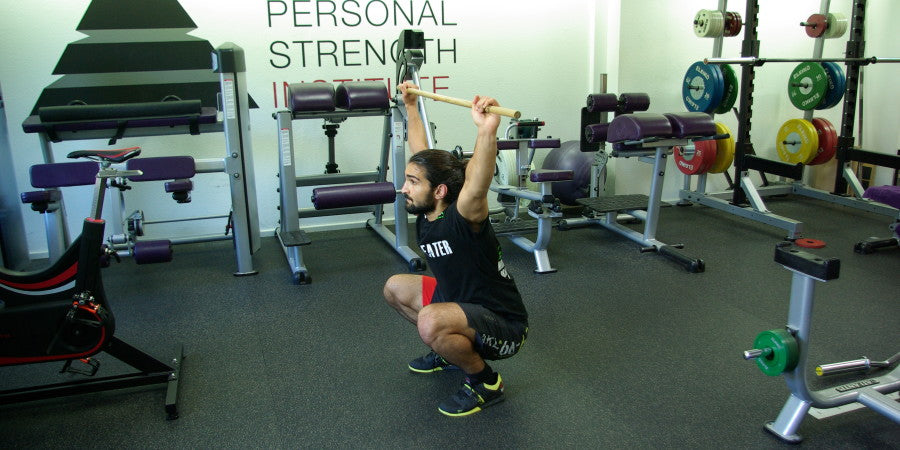"Ask the Coach" is the column in which Wolfgang Unsöld answers your questions. The book of the same name is available right here on Amazon.
Question: I really enjoyed reading your new book. Practical, fluid, entertaining and reduced to the most important things. I was through in 2 hours. And I took a whole new set of suggestions and tips for my training with me. I liked that very much. One thing that surprised me though. is why there is no chapter on overhead squats. The overhead squat is very popular right now. Why isn't there anything about her in the book? Michael
WU: I do overhead squats regularly. But never as an exercise in training. But exclusively for the assessment of mobility. The overhead squat is actually the best because it is the most efficient screen for determining the mobility of all relevant major joints - ankle, hip and shoulder. No other screen gives such a deep insight into the mobility of all these primarily relevant joints in such a short time.
But why isn't the overhead squat listed in The Perfect Squat?
The aim of the book is to give a practical insight into the subject of squatting. The overhead squat assessment is beyond the scope of a book as the evaluation and interpretation of this screen is very in-depth, which definitely requires a practical component of learning. No book can explain the use of the overhead squat as an assessment tool in such depth that the reader takes all the details and the translation into practice with them. For this I used more than an hour during module 5 of the YPSI Trainer License with explanations on interpretation and many practical examples in which each participant performs an overhead squat with a basic style and all participants then analyze it for a double - since direct and indirect - learning effect for everyone Participant. The more technical a learning objective, the more crucial the practical component of learning. The overhead squat is only marginally related to the squat issue because the overhead squat is a global assessment. Topics such as variants, techniques, methods, tools and periodization examples are much more decisive and practice-relevant here. And the overhead squat as an assessment is a very complex, technical topic, which is therefore fundamentally beyond the scope of a book.
Why don't I use the overhead squat as an exercise in my workout?
I never use overhead squats in training because the training effect is too low and the risk of injury is too high. The insufficient training effect is primarily based on the fact that the adaptations of muscles and nervous system through strength training are primarily stimulated by tension on the muscle. This tension comes from using external resistance that is close to 1RM for its training relevance. Squatting 40kg doesn't increase 1RM from 110kg to 120kg. With 100kg squats, however, macher very reliably increases the 1RM from 110kg to 120kg. Now, when someone squats 100kg, whether the 100kg is on the upper back or overhead has less of an effect on the tension in the primarily worked muscles, the quads, hamstrings, glutes and lower back. However, laying 100kg on your back as in the squat or the collarbone as in the front squat is much easier and, above all, safer than pushing 100kg overhead with either a wide grip and holding it there, or even with straight arms and a wide grip from the to lift rack. The ability for the lower body to safely bring training-relevant weight into this position and to stabilize it there is clearly limiting. Using a lighter weight can result in a relevant, albeit small, isometric training stimulus on the shoulder girdle. However, a lower weight has no training-relevant effect on the primary muscles around the knees and hips. Therefore, the overhead squat is not suitable for building global and local strength and muscle in the primarily relevant muscles.
This makes the overhead squat an excellent assessment. But at the same time an exercise that has no place in training, that cannot be trained safely and progressively with training-relevant weights.
As with many things there are exceptions, the overhead squat can be incorporated as a discipline into CrossFit training where 40-60kg in the overhead squat often needs to be moved for time or repetitions. And by a few weightlifting training systems, the overhead squat is also sporadically incorporated into the routine as an assistance exercise to the squat squat at a very late stage when that is an individual weightlifter's limiting factor.
Good luck with the overhead squat as an assessment!
Wolfgang's latest book "The Perfect Knee Bend" is available right here in the YPSI Online Shop and on Amazon (incl. Prime and Kindle).
If you have a question for the Ask the Coach column, post it in the comments below and with a little luck your question will be selected for an upcoming post or the next Ask the Coach book.
Image: YPSI Coach and MMA Pro Mert Özyildirim overhead squat with a broom handle.

